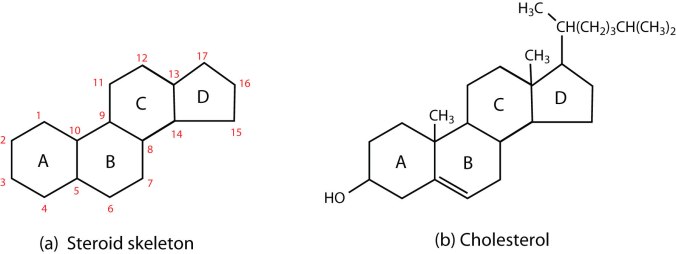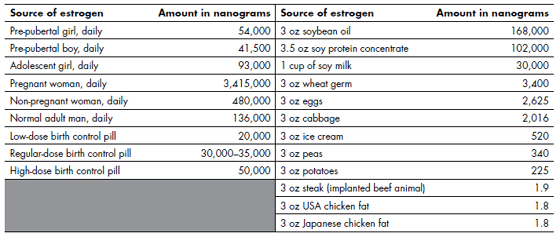Jayachanda K.- Biology
The rise of large scale chicken farming does away with traditional farming methods in order to provide competitively priced products. In doing so, the well being of the chicken is often sacrificed with the aims of maximizing profit and reducing expenses. These businesses may resort to steroids and genetic modification in return for larger yields and reduced expenses.
Steroids are a group of organic molecules belonging to the class of lipids having a molecular structure of four carbon rings. They assist in initiating bone and muscle growth, regulating metabolic function, helping immune responses, and synthesizing tissues. They range from cholesterol, the most prevalent steroid in mammals, to the sex hormones testosterone and estrogen.

http://catalog.flatworldknowledge.com/bookhub/reader/2547?e=gob-ch17_s04
Steroid use in poultry production has been banned since the 1950s so no specific data on the effect of steroids on chicken well being has been recorded. However, the cattle industry operates under separate regulations where steroid use is unrestricted so their effects on cows can assumed to be similar on chickens. Still the effects of steroid use in cows cannot be used to generalize about steroid use in chickens accurately because chickens don’t reap any benefits from growth hormones whereas cows produce more lean meat. Hormones commonly used include progesterone, testosterone, oestrogen, zeranol and trenbolone acetate. Progesterone, testosterone, and oestrogen are naturally produced hormones integral to healthy development and reproduction while zeranol and trenbolone acetate are synthetic. These hormones are often administered in a pellet form and implanted behind the cow’s ear where they will be gradually absorbed over the course of 100-120 days. Their overall effects include increasing growth, reducing feed requirements, and improving carcass leaness. In sum, all these act to reduce costs and raise profits.
Proposed steroid use in chickens could negatively affect human health through their consumption. Diethylstilbestrol, a synthetic oestrogen drug used in the 1960s, was banned after data suggested it increased the risk of vaginal cancer in daughters of treated women (Gandhi and Snedeker, 2000). Hormones used for chicken farming could behave in a similar fashion when consumed by humans. However, meat consumption accounts for a negligible proportion of the daily intake of steroids leading Handa et al. (2000) to conclude that oestrogen intake from meat can be disregarded as a threat to human health. Furthermore, the natural amount of steroids produced daily by humans is far greater than the quantities found in food products.

An alternative to steroid use involves the creation of genetically modified chickens. A genetically modified organism (GMO) has has its DNA altered in a manner which doesn’t occur naturally through mating or breeding. Possible concerns with genetically modified organisms include the transferred gene causing new allergens in humans along with the threat of the gene escaping into the local environment. This would cause the GMO to compete with native species for resources. In addition, native species who have acquired the gene of interest through mating could possibly gain an unfair advantage against rival species.
Broiler chickens have been bred selectively since the mid-20th century to produce more breast meat quicker than normal chickens. Broiler chickens weigh three kilograms, have 80% larger breasts, and take up to six weeks to become their full size. Regular chickens weigh half as much as broiler chickens, and need fifteen weeks to hit their target weight. Conversely, the broiler chicken’s greater weight contributes to a host of health problems. A 2008 study consisting of more than 50,000 chickens found that 27% had difficulties moving and 3% were unable to move at the age of 40 days. The extra weight causes microfractures and degenerative bone disease which could possibly account for their immobility.

http://www.seattleorganicrestaurants.com/vegan-whole-foods/genetically-modified-chickens/
In contrast, genetically modified chickens can provide benefits through unconventional means. In 2008, the United States Food and Drug Administration approved a genetically modified chicken that produces Kamuna, derived from organic substances, in its eggs to treat people with Wolman disease, also known as lysomal acid lilpase deficiency. Wolman disease prevents the cells of afflicted individuals to metabolize fats which could contribute to future liver and cardiovascular diseases.
Bibliography
http://www.newworldencyclopedia.org/entry/Steroid
http://catalog.flatworldknowledge.com/bookhub/reader/2547?e=gob-ch17_s04
http://www.who.int/foodsafety/areas_work/food-technology/faq-genetically-modified-food/en/
http://www.seattleorganicrestaurants.com/vegan-whole-foods/genetically-modified-chickens/
http://www.ibtimes.com/gmo-chicken-fda-approves-genetically-modified-hens-medicine-not-food-2219819